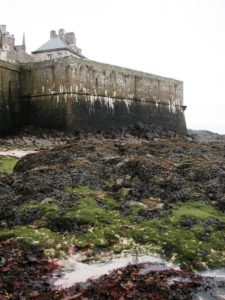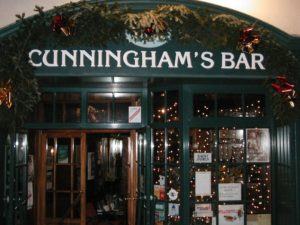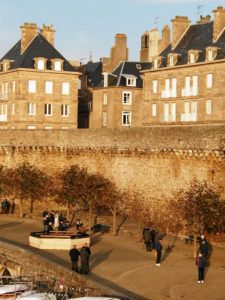Saint-Malo is an ancient walled port city in Brittany on the English Channel coastline of northwestern France. The population is approximately 44,620, but this can increase to 200,000 during the summer tourist season.

Photo credit: Storm Cunningham
In 17th and 18th centuries, Saint-Malo became notorious as the home of the corsairs, French privateers and (sometimes) pirates. The corsairs of Saint-Malo not only forced English ships passing up the Channel to pay tribute, but also brought wealth from further afield.
Jacques Cartier, who sailed up the Saint Lawrence River and visited the future sites of Quebec City and Montreal—and is thus credited as the discoverer of Canada—lived in and sailed from Saint-Malo.
So did the first colonists to settle the Falkland Islands, hence the Islands’ French name “Îles Malouines,” which eventually gave rise to the Spanish name “Islas Malvinas.”
In 1940, Nazis invaded and occupied Saint-Malo. Towards the end of the war, in 1944, the Allies believed that the Axis powers had thousands of troops and major armaments within the city walls, although it turned out that there were actually fewer than 100 troops manning just two anti-aircraft installations.

Storm’s favorite Saint-Malo bar.
Photo credit: Storm Cunningham
Saint-Malo was rebuilt over a 12-year period from 1948–60. Over the 12-year span from 1948-1960, the city was rebuilt brick-by-brick by the determined Malouins. However, instead of attempting to modernize the style of architecture in Saint-Malo, it was restored to its original glory, maintaining its medieval character.
This saved it from the sterility of so many other rebuilt European (especially German) cities. Many of them are plagued with hideous Brutalist structures from the 60s and 70s, making them look like Soviet penitentiaries.

Photo credit: Storm Cunningham
Those in charge of its reconstruction planned it to be close to the original, with a few modifications. While the castle was replicated and transformed into the city hall, the hospital and prison were relocated outside of the city walls.
Mansions were rebuilt with identical granite facades and only a handful of half-timbered homes from the 1600s were retained. In contrast to other cities that were rebuilt after the war, such as Warsaw and Dresden, there are no obvious signs of modern construction.
Saint-Malo seems to be the perfect case study to examine a time when European cities were developed around Medieval transit systems, when walkability was necessary, and when the wealthiest lived in the urban core.
Featured panoramic photo by Jean-Christophe Windland via Wikipedia.
See article by Kaley Overstreet and more photos in Arch Daily.

